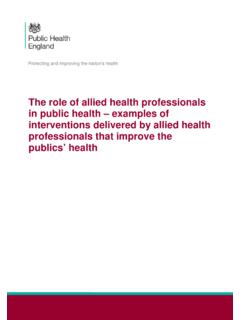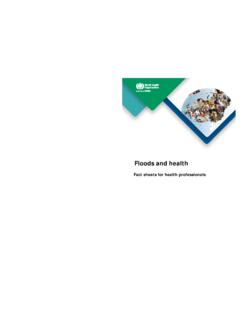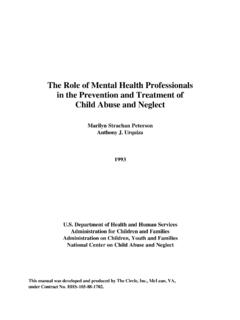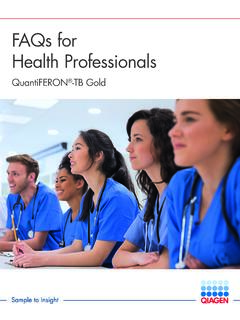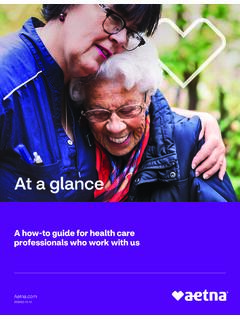Transcription of The ABCs of Hepatitis – for Health Professionals
1 The ABCs of HepatitisHEPATITIS A is caused by the Hepatitis A virus (HAV) Hepatitis B is caused by the Hepatitis B virus (HBV) Hepatitis C is caused by the Hepatitis C virus (HCV) Statistics Estimated 2,500 new infections in 2014 Estimated 19,200 new infections in 2014 Estimated 850,000 million people with chronic HBV infection Estimated 30,500 new infections in 2014 Estimated million people with chronic HCV infection Routes of TransmissionIngestion of fecal matter, even in microscopic amounts, from.
2 Close person-to-person contact with an infected person Sexual contact with an infected person Ingestion of contaminated food or drinksContact with infectious blood, semen, and other body fluids primarily through: Birth to an infected mother Sexual contact with an infected person Sharing of contaminated needles, syringes, or other injection drug equipment Needlesticks or other sharp instrument injuriesContact with blood of an infected person primarily through: Sharing of contaminated needles, syringes, or other injection drug equipment Less commonly through.
3 Sexual contact with an infected person Birth to an infected mother Needlestick or other sharp instrument injuriesPersons at Risk Travelers to regions with intermediate or high rates of Hepatitis A Sex contacts of infected persons Household members or caregivers of infected persons Men who have sex with men Users of certain illegal drugs (injection and non-injection) Persons with clotting-factor disorders Infants born to infected mothers Sex partners of infected persons Persons with multiple sex partners Persons with a sexually transmitted disease (STD)
4 Men who have sex with men Injection drug users Household contacts of infected persons Healthcare and public safety workers exposed to blood on the job Hemodialysis patients Residents and staff of facilities for developmentally disabled persons Travelers to regions with intermediate or high rates of Hepatitis B (HBsAg prevalence of 2%) Current or former injection drug users Recipients of clotting factor concentrates before 1987 Recipients of blood transfusions or donated organs before July 1992 Long-term hemodialysis patients Persons with known exposures to HCV ( , healthcare workers after needlesticks, recipients of blood or organs from a donor who later tested positive for HCV) HIV-infected persons Infants born to infected mothersIncubation Period15 to 50 days (average: 28 days)45 to 160 days (average.)
5 120 days)14 to 180 days (average: 45 days)Symptoms of Acute InfectionSymptoms of all types of viral Hepatitis are similar and can include one or more of the following: Fever Fatigue Loss of appetite Nausea Vomiting Abdominal pain Gray-colored bowel movements Joint pain JaundiceLikelihood of Symptomatic Acute infection < 10% of children < 6 years have jaundice 40% 50% of children age 6 14 years have jaundice 70% 80% of persons > 14 years have jaundice < 1% of infants < 1 year develop symptoms 5% 15% of children age 1-5 years develop symptoms 30% 50% of persons > 5 years develop symptoms Note.
6 Symptoms appear in 5% 15% of newly infected adults who are immunosuppressed 20% 30% of newly infected persons develop symptoms of acute disease Potential for Chronic InfectionNone Among unimmunized persons, chronic infection occurs in >90% of infants, 25% 50% of children aged 1 5 years, and 6% 10% of older children and adults 75% 85% of newly infected persons develop chronic infection 15% 25% of newly infected persons clear the virusSeverityMost persons with acute disease recover with no lasting liver damage; rarely fatal Most persons with acute disease recover with no lasting liver damage.
7 Acute illness is rarely fatal 15% 25% of chronically infected persons develop chronic liver disease, including cirrhosis, liver failure, or liver cancer 1,800 persons in the United States die with HBV-related liver disease as documented from death certificates Acute illness is uncommon. Those who do develop acute illness recover with no lasting liver damage. 60% 70% of chronically infected persons develop chronic liver disease 5% 20% develop cirrhosis over a period of 20 30 years 1% 5% will die from cirrhosis or liver cancer 19.
8 600 deaths in 2014 Continued on next pageHEPATITIS A Hepatitis BHEPATITIS CSerologic Tests for Acute Infection IgM anti-HAV HBsAg in acute and chronic infection IgM anti-HBc is positive in acute infection only No serologic marker for acute infectionSerologic Tests for Chronic Infection Not applicable no chronic infection HBsAg (and additional markers as needed) Screening assay (EIA or CIA) for anti-HCV Verification by an additional, more specific assay ( , nucleic acid testing (NAT) for HCV RNA)Screening Recommendations for Chronic Infection Not applicable no chronic infection Note: Screening for past acute infection is generally not recommendedTesting is recommended for.
9 All pregnant women Persons born in regions with intermediate or high rates of Hepatitis B (HBsAg prevalence of 2%) born persons not vaccinated as infants whose parents were born in regions with high rates of Hepatitis B (HBsAg prevalence of 8%) Infants born to HBsAg-positive mothers Household, needle-sharing, or sex contacts of HBsAg-positive persons Men who have sex with men Injection drug users Patients with elevated liver enzymes (ALT/AST) of unknown etiology Hemodialysis patients Persons needing immunosuppressive or cytotoxic therapy HIV-infected persons Donors of blood, plasma, organs, tissues, or semenTesting is recommended for.
10 Persons born from 1945 1965 Persons who currently inject drugs or who have injected drugs in the past, even if once or many years ago Recipients of clotting factor concentrates before 1987 Recipients of blood transfusions or donated organs before July 1992 Long-term hemodialysis patients Persons with known exposures to HCV ( , healthcare workers after needlesticks, recipients of blood or organs from a donor who later tested positive for HCV) HIV-infected persons Children born to infected mothers (do not test before age 18 mos.)













